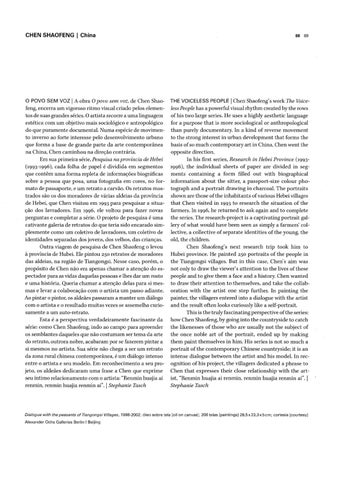CHEN SHAOFENG
I China
88 89
o POVO SEM VOZ I A obra O povo sem voz, de Chen Shao-
THE VOICELESS PEOPLE I Chen Shaofeng's work The Voice-
feng, encerra um vigoroso ritmo visual criado pelos elementos de suas grandes séries. O artista recorre a uma linguagem estética com um objetivo mais sociológico e antropológico do que puramente documental. Numa espécie de movimento inverso ao forte interesse pelo desenvolvimento urbano que forma a base de grande parte da arte contemporânea na China, Chen caminhou na direção contrária. Em sua primeira série, Pesquisa na província de Hebei (1993-1996), cada folha de papel é dividida em segmentos que contêm uma forma repleta de informações biográficas sobre a pessoa que posa, uma fotografia em cores, no formato de passaporte, e um retrato a carvão. Os retratos mostrados são os dos moradores de várias aldeias da província de Hebei, que Chen visitou em 1993 para pesquisar a situação dos lavradores. Em 1996, ele voltou para fazer novas perguntas e completar a série. O projeto de pesquisa é uma cativante galeria de retratos do que teria sido encarado simplesmente como um coletivo de lavradores, um coletivo de identidades separadas dos jovens, dos velhos, das crianças. Outra viagem de pesquisa de Chen Shaofeng o levou à província de Hubei. Ele pintou 250 retratos de moradores das aldeias, na região de Tiangongsi. Nesse caso, porém, o propósito de Chen não era apenas chamar a atenção do espectador para as vidas daquelas pessoas e lhes dar um rosto e uma história. Queria chamar a atenção delas para si mesmas e levar a colaboração com o artista um passo adiante. Ao pintar o pintor, os aldeães passaram a manter um diálogo com o artista e o resultado muitas vezes se assemelha curiosamente a um auto-retrato. Esta é a perspectiva verdadeiramente fascinante da série: como Chen Shaofeng, indo ao campo para apreender os semblantes daqueles que não costumam ser tema da arte do retrato, outrora nobre, acabaram por se fazerem pintar a si mesmos no artista. Sua série não chega a ser um retrato da zona rural chinesa contemporânea, é um diálogo intenso entre o artista e seu modelo. Em reconhecimento a seu projeto, os aldeães dedicaram uma frase a Chen que exprime seu íntimo relacionamento com o artista: "Renmin huajia ai renmin, renmin huajia renmin ai". I Stephanie Tasch
less People has a powerful visual rhythm created by the rows of his two large series. He uses a highly aesthetic language for a purpose that is more sociological or anthropological than purely documentary. In a kind of reverse movement to the strong interest in urban development that forms the basis of so much contemporary art in China, Chen went the opposite direction. In his first series, Research in Hebei Province (19931996), the individual sheets of paper are divided in segments containing a form filled out with biographical information about the sitter, a passport-size colour photograph and a portrait drawing in charcoal. The portraits shown are those of the inhabitants of various Hebei villages that Chen visited in 1993 to research the situation of the farmers. In 1996, he returned to ask again and to complete the series. The research-project is a captivating portrait gallery ofwhat would have been seen as simplya farmers' collective, a collective of separate identities of the young, the old, the children. Chen Shaofeng' s next research trip took him to Hubei province. He painted 250 portraits of the people in the Tiangongsi villages. But in this case, Chen' s aim was not only to draw the viewer' s attention to the lives of these people and to give them a face and a history. Chen wanted to draw their attention to themselves, and take the collaboration with the artist one step further. In painting the painter, the villagers entered into a dialogue with the artist and the result often looks curiously like a self-portrait. This is the truly fascinating perspective of the series: how Chen Shaofeng, by going into the countryside to catch the likenesses of those who are usually not the subject of the once noble art of the portrait, ended up by making them paint themselves in him. His series is not so much a portrait of the contemporary Chinese countryside; it is an intense dialogue between the artist and his model. In recognition of his project, the villagers dedicated a phrase to Chen that expresses their dose relationship with the artist, "Renmin huajia ai renmin, renmin huajia renmin ai". I Stephanie Tasch
Dialogue with the peasants of Tiangongsi Vil/ages, 1998-2002; óleo sobre tela [oil on canvas]; 200 telas [paintings] 28,5x 23,3 x 5 cm; cortesia [courtesy] Alexander Ochs Galleries Berlin I Beijing
